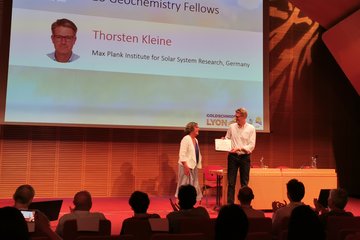Alle Typen
1.
Zeitschriftenartikel
Beyond 3 au from the Sun: The Hypervolatiles CH4, C2H6, and CO in the Distant Comet C/2006 W3 (Christensen). Astronomical Journal 153, 241 (2017)
2.
Zeitschriftenartikel
A new model for the ν1 vibrational band of HCN in cometary comae, with application to three comets. Astronomy and Astrophysics 551, A51 (2013)
3.
Zeitschriftenartikel
A new model for the ν1 vibrational band of HCN in cometary comae, with application to three comets. Astronomy and Astrophysics 551, A51 (2013)
4.
Zeitschriftenartikel
Ground-Based Infrared Detections of CO in the Centaur-comet 29P/Schwassmann-Wachmann 1 at 6.26 AU from the Sun. Astrophysical Journal 766, 100 (2013)
5.
Zeitschriftenartikel
The Chemical Composition of CO-rich Comet C/2009 P1 (Garradd) AT R h = 2.4 and 2.0 AU before Perihelion. Astrophysical Journal 748, L13 (2012)
6.
Zeitschriftenartikel
Erratum: ``The Chemical Composition of CO-Rich Comet C/2009 P1 (Garradd) At RH = 2.4 and 2.0 AU before Perihelion'' (vol 748, L13, 2012). Astrophysical Journal 756 (2), L42 (2012)
7.
Zeitschriftenartikel
Temporal and Spatial Aspects of Gas Release During the 2010 Apparition of Comet 103P/Hartley 2. Astrophysical Journal 734, L7 (2011)
8.
Vortrag
Beyond 3 AU from the Sun: "Hypervolatiles" in Distant Comets. DPS Meeting #48, Pasadena, USA (2016)
9.
Vortrag
Ethane (C2H6), Methane (CH4), and Carbon Monoxide (CO) in the Coma of Comet C/2006 W3 (Christensen) Beyond 3.2 AU from the Sun. DPS Meeting 45, Tucson, AZ, USA (2014)
10.
Poster
Pre- And Post-Perihelion Results On The Unexpectedly-Bright Comet C/2012 F6 (Lemmon) Using IR Spectroscopy. DPS Meeting 45, Tucson, AZ, USA (2014)
11.
Hochschulschrift - Doktorarbeit
The compositon of cometary ices as inferred from measured production rates of volatiles. Dissertation, Technische Universität Braunschweig (2010)











